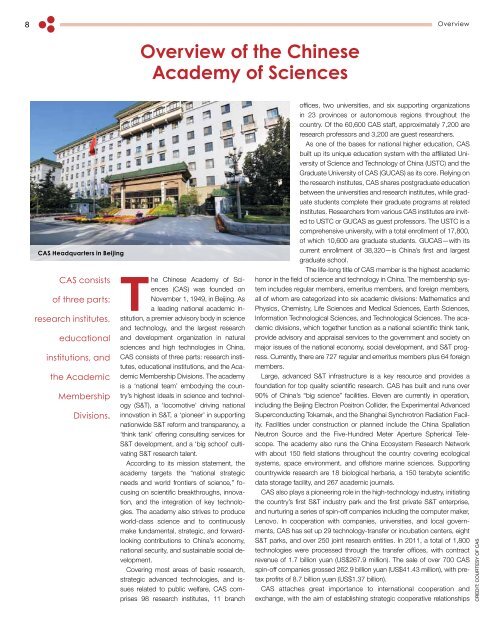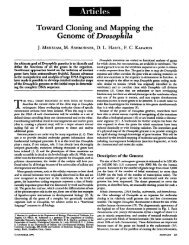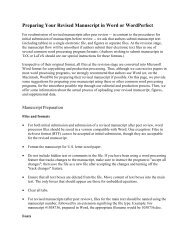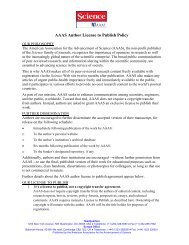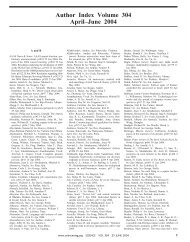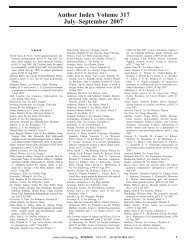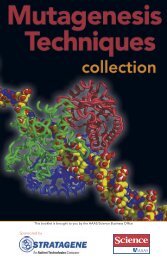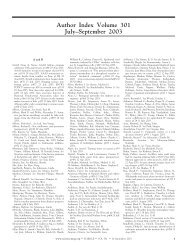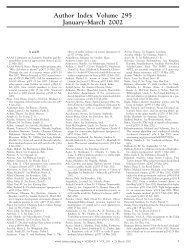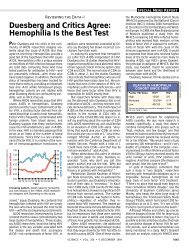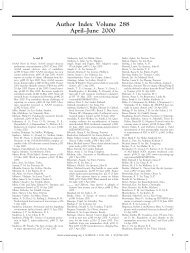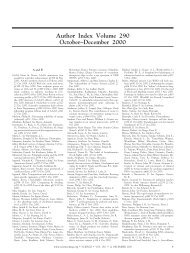Chinese Academy of Sciences (PDF) - low res version
Chinese Academy of Sciences (PDF) - low res version
Chinese Academy of Sciences (PDF) - low res version
Create successful ePaper yourself
Turn your PDF publications into a flip-book with our unique Google optimized e-Paper software.
8<br />
CAS Headquarters in Beijing<br />
CAS consists<br />
<strong>of</strong> three parts:<br />
<strong>res</strong>earch institutes,<br />
educational<br />
institutions, and<br />
the Academic<br />
Membership<br />
Divisions.<br />
Overview <strong>of</strong> the <strong>Chinese</strong><br />
<strong>Academy</strong> <strong>of</strong> <strong>Sciences</strong><br />
The <strong>Chinese</strong> <strong>Academy</strong> <strong>of</strong> <strong>Sciences</strong><br />
(CAS) was founded on<br />
November 1, 1949, in Beijing. As<br />
a leading national academic institution,<br />
a premier advisory body in science<br />
and technology, and the largest <strong>res</strong>earch<br />
and development organization in natural<br />
sciences and high technologies in China,<br />
CAS consists <strong>of</strong> three parts: <strong>res</strong>earch institutes,<br />
educational institutions, and the Academic<br />
Membership Divisions. The academy<br />
is a ‘national team’ embodying the country’s<br />
highest ideals in science and technology<br />
(S&T), a ‘locomotive’ driving national<br />
innovation in S&T, a ‘pioneer’ in supporting<br />
nationwide S&T reform and transparency, a<br />
‘think tank’ <strong>of</strong>fering consulting services for<br />
S&T development, and a ‘big school’ cultivating<br />
S&T <strong>res</strong>earch talent.<br />
According to its mission statement, the<br />
academy targets the “national strategic<br />
needs and world frontiers <strong>of</strong> science,” focusing<br />
on scientific breakthroughs, innovation,<br />
and the integration <strong>of</strong> key technologies.<br />
The academy also strives to produce<br />
world-class science and to continuously<br />
make fundamental, strategic, and forwardlooking<br />
contributions to China’s economy,<br />
national security, and sustainable social development.<br />
Covering most areas <strong>of</strong> basic <strong>res</strong>earch,<br />
strategic advanced technologies, and issues<br />
related to public welfare, CAS comprises<br />
98 <strong>res</strong>earch institutes, 11 branch<br />
Overview<br />
<strong>of</strong>fices, two universities, and six supporting organizations<br />
in 23 provinces or autonomous regions throughout the<br />
country. Of the 60,600 CAS staff, approximately 7,200 are<br />
<strong>res</strong>earch pr<strong>of</strong>essors and 3,200 are guest <strong>res</strong>earchers.<br />
As one <strong>of</strong> the bases for national higher education, CAS<br />
built up its unique education system with the affiliated University<br />
<strong>of</strong> Science and Technology <strong>of</strong> China (USTC) and the<br />
Graduate University <strong>of</strong> CAS (GUCAS) as its core. Relying on<br />
the <strong>res</strong>earch institutes, CAS sha<strong>res</strong> postgraduate education<br />
between the universities and <strong>res</strong>earch institutes, while graduate<br />
students complete their graduate programs at related<br />
institutes. Researchers from various CAS institutes are invited<br />
to USTC or GUCAS as guest pr<strong>of</strong>essors. The USTC is a<br />
comprehensive university, with a total enrollment <strong>of</strong> 17,800,<br />
<strong>of</strong> which 10,600 are graduate students. GUCAS—with its<br />
current enrollment <strong>of</strong> 38,320—is China’s first and largest<br />
graduate school.<br />
The life-long title <strong>of</strong> CAS member is the highest academic<br />
honor in the field <strong>of</strong> science and technology in China. The membership system<br />
includes regular members, emeritus members, and foreign members,<br />
all <strong>of</strong> whom are categorized into six academic divisions: Mathematics and<br />
Physics, Chemistry, Life <strong>Sciences</strong> and Medical <strong>Sciences</strong>, Earth <strong>Sciences</strong>,<br />
Information Technological <strong>Sciences</strong>, and Technological <strong>Sciences</strong>. The academic<br />
divisions, which together function as a national scientific think tank,<br />
provide advisory and appraisal services to the government and society on<br />
major issues <strong>of</strong> the national economy, social development, and S&T prog<strong>res</strong>s.<br />
Currently, there are 727 regular and emeritus members plus 64 foreign<br />
members.<br />
Large, advanced S&T infrastructure is a key <strong>res</strong>ource and provides a<br />
foundation for top quality scientific <strong>res</strong>earch. CAS has built and runs over<br />
90% <strong>of</strong> China’s “big science” facilities. Eleven are currently in operation,<br />
including the Beijing Electron Positron Collider, the Experimental Advanced<br />
Superconducting Tokamak, and the Shanghai Synchrotron Radiation Facility.<br />
Facilities under construction or planned include the China Spallation<br />
Neutron Source and the Five-Hundred Meter Aperture Spherical Telescope.<br />
The academy also runs the China Ecosystem Research Network<br />
with about 150 field stations throughout the country covering ecological<br />
systems, space environment, and <strong>of</strong>fshore marine sciences. Supporting<br />
countrywide <strong>res</strong>earch are 18 biological herbaria, a 150 terabyte scientific<br />
data storage facility, and 267 academic journals.<br />
CAS also plays a pioneering role in the high-technology industry, initiating<br />
the country’s first S&T industry park and the first private S&T enterprise,<br />
and nurturing a series <strong>of</strong> spin-<strong>of</strong>f companies including the computer maker,<br />
Lenovo. In cooperation with companies, universities, and local governments,<br />
CAS has set up 29 technology-transfer or incubation centers, eight<br />
S&T parks, and over 250 joint <strong>res</strong>earch entities. In 2011, a total <strong>of</strong> 1,800<br />
CAS<br />
technologies were processed through the transfer <strong>of</strong>fices, with contract<br />
OF<br />
revenue <strong>of</strong> 1.7 billion yuan (US$267.9 million). The sale <strong>of</strong> over 700 CAS<br />
spin-<strong>of</strong>f companies grossed 262.9 billion yuan (US$41.43 million), with pretax<br />
pr<strong>of</strong>its <strong>of</strong> 8.7 billion yuan (US$1.37 billion).<br />
COURTESY<br />
CAS attaches great importance to international cooperation and<br />
exchange, with the aim <strong>of</strong> establishing strategic cooperative relationships CREDIT:


